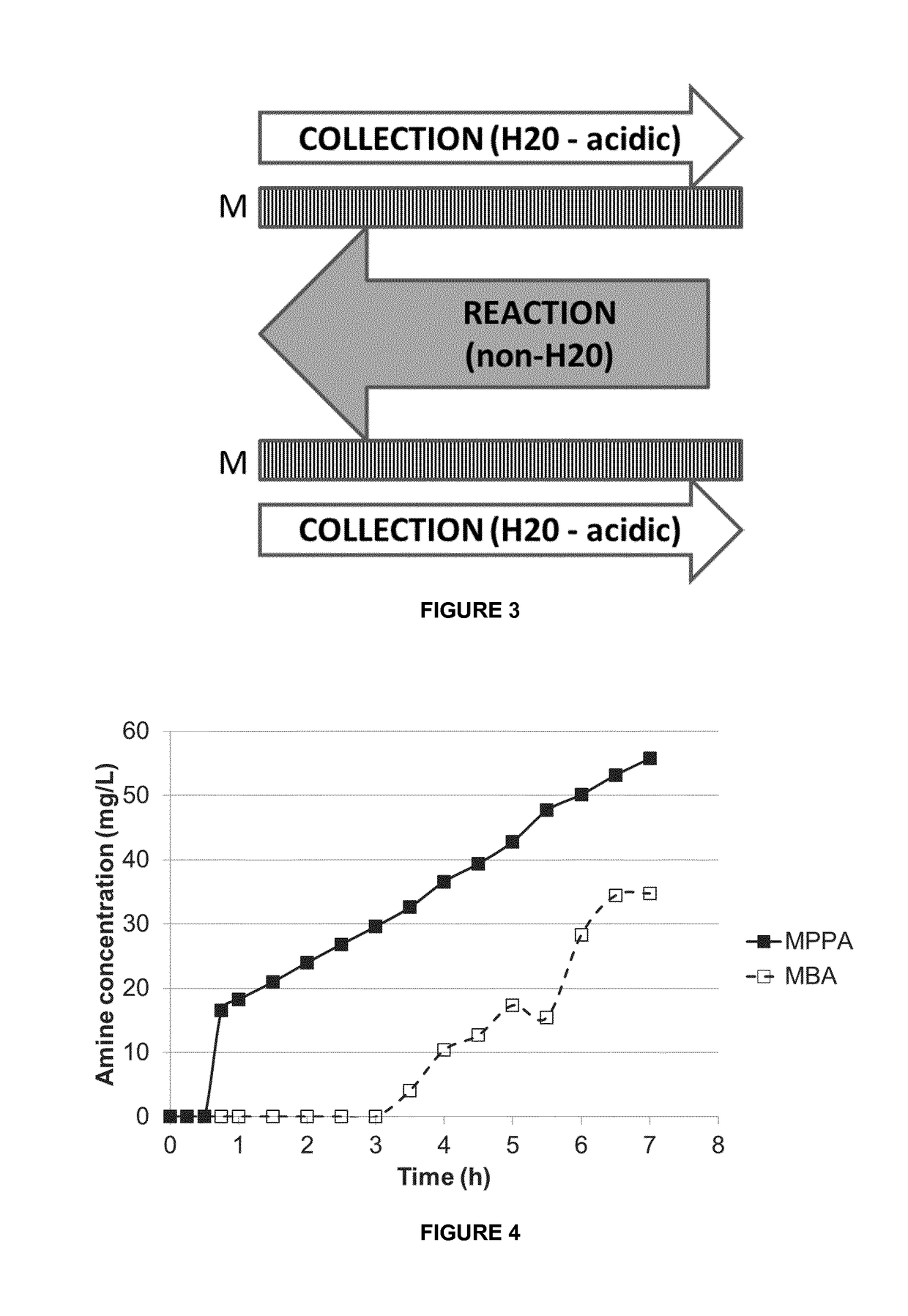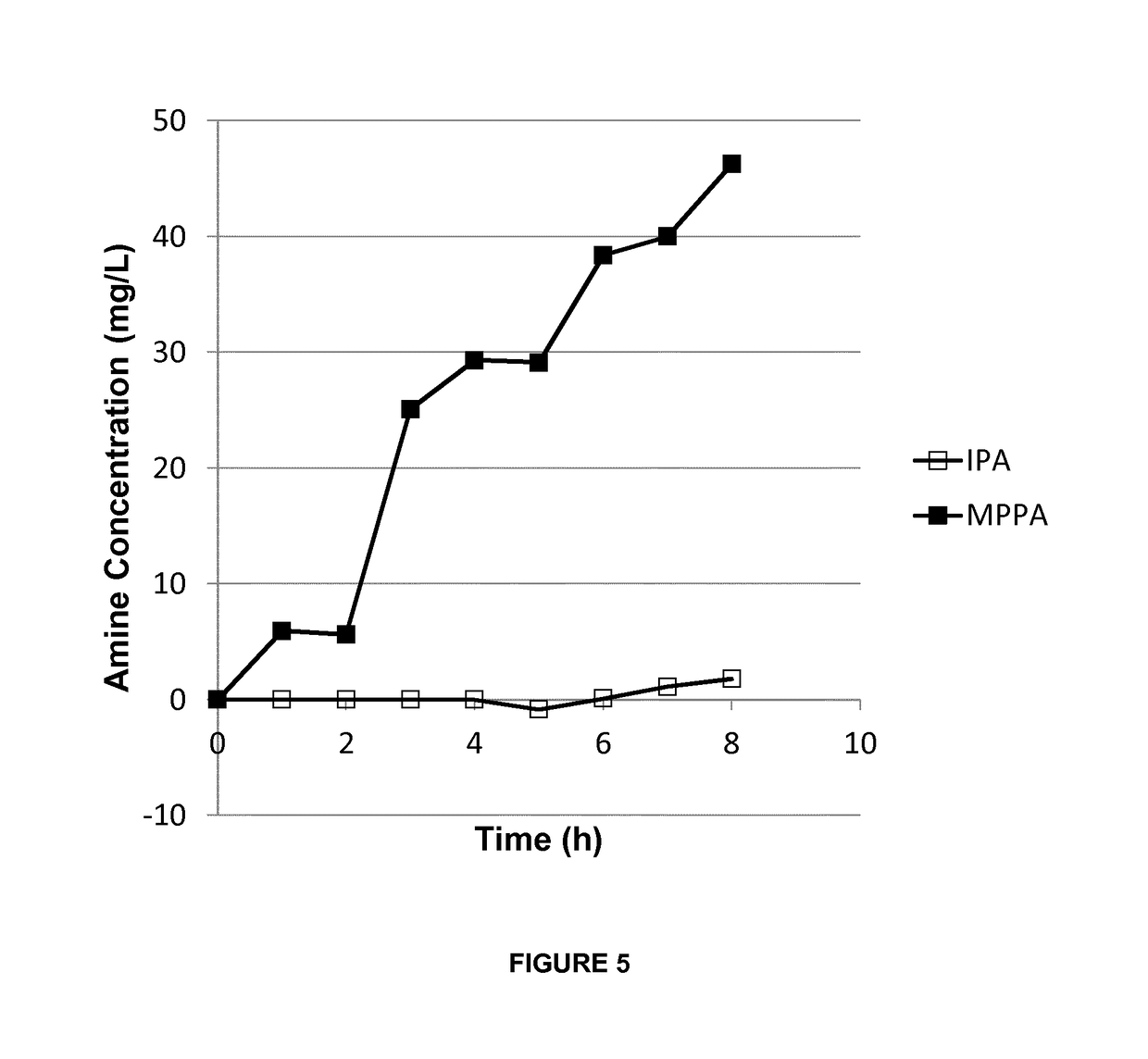Process for the separation of organic compounds
a technology of organic compounds and separation methods, applied in the field of improved methods for the separation of organic compounds, can solve the problems of limiting the synthesis of high chiral amine yields, hindering reaction, and prone to substrate and product inhibition, so as to achieve efficient and stable membrane separation process, high mechanical, thermal and hydrothermal stability
- Summary
- Abstract
- Description
- Claims
- Application Information
AI Technical Summary
Benefits of technology
Problems solved by technology
Method used
Image
Examples
example 1
[0121]A mixture of MPPA and MBA in a pH 10 aqueous buffer (feed solution) was applied to a first compartment of a membrane contactor module, with the second compartment comprising a sodium acetate buffer (pH 3) (collection solution). The membrane separation was performed at a flow rate of 20 l / h, a temperature of 30° C. and a transmembrane pressure of 300-500 mbar. Feed and collection solutions were continuously recycled in the membrane contactor module. The membrane used was a phenyl phosphonic acid functionalized ceramic membrane, wherein both the external surface as the internal surface of the pores was linked to the organic moiety. The membrane before functionalization had a titanium oxide top layer with pore size of 0.9 nm. The amine concentration in the extracting sodium acetate solution was followed up over time (FIG. 4). The amines used are listed in Table 1. They have a different octanol / water partition ration (expressed as log P value).
TABLE 1MPPA (*)MBA (*)LogP2.2641.7pKa...
example 2
[0127]A mixture of isopropyl amine (IPA) and 1-methyl-3-phenylpropylamine (MPPA) in a pH 10 aqueous buffer (feed solution) was applied to a first compartment of a membrane contactor module, with the second compartment comprising a sodium acetate buffer (pH 3) (collection solution). The membrane separation was performed at a flow rate of 20 l / h, temperature of 30° C. and transmembrane pressure of 300 to 500 mbar. Feed and collection solutions were continuously recycled in the membrane contactor module. The membrane used was a phenyl phosphonic acid functionalized ceramic membrane (as in Example 1), wherein both the external surface as the internal surface of the pores was linked to the organic moiety. The amine concentration in the extracting sodium acetate solution was followed up over time (FIG. 5).
[0128]The amines used are listed in Table 2. They have a different octanol / water partition ration (expressed as log P value), but similar pKa value, and, consequently, have a similar % o...
example 3
[0131]An enzymatically catalysed transamination reaction is performed in an organic solvent, using benzyl acetone (BA) and isopropyl amine (IPA) as respectively substrate ketone and substrate amine. This setup is chosen in view of the limited solubility of BA in aqueous liquids (10 mM or 1.48 g / 1). The resulting products are acetone (as co-product ketone) and (S-)1-methyl-3-phenylpropylamine (S-MPPA—a chiral amine). This reaction is prone to product inhibition by MPPA.
[0132]The reaction mixture is passed through a membrane contactor module, using an acidic sodium acetate buffer (pH 3) as extracting solution. In line with example 2, the MPPA product efficiently passes the membrane and MPPA can be obtained with a high yield, while the amine donor IPA mainly remains in the feed solution.
PUM
| Property | Measurement | Unit |
|---|---|---|
| pKa | aaaaa | aaaaa |
| pKa | aaaaa | aaaaa |
| pKa | aaaaa | aaaaa |
Abstract
Description
Claims
Application Information
 Login to View More
Login to View More - R&D
- Intellectual Property
- Life Sciences
- Materials
- Tech Scout
- Unparalleled Data Quality
- Higher Quality Content
- 60% Fewer Hallucinations
Browse by: Latest US Patents, China's latest patents, Technical Efficacy Thesaurus, Application Domain, Technology Topic, Popular Technical Reports.
© 2025 PatSnap. All rights reserved.Legal|Privacy policy|Modern Slavery Act Transparency Statement|Sitemap|About US| Contact US: help@patsnap.com



